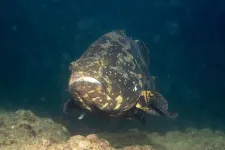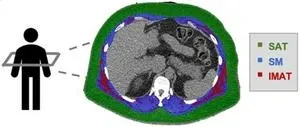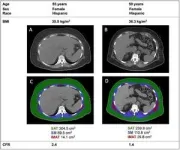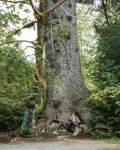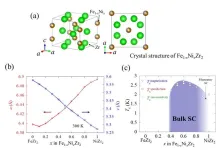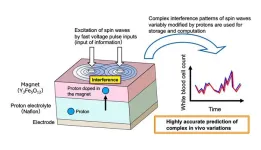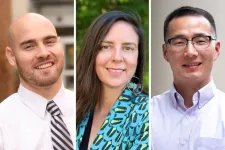(Press-News.org)
Ecologists from the School of Biological Sciences (SBS) and the Swire Institute of Marine Science (SWIMS) at The University of Hong Kong (HKU) have identified significant ecological risks associated with the release of hybrid groupers into Hong Kong’s coastal waters, a practice often linked to religious ‘mercy release’ rituals.
Their study highlights how the Tiger Grouper-Giant Grouper hybrid (TGGG), also known as the Sabah grouper, disrupts local marine ecosystems by exploiting unique ecological niches and potentially becoming a dominant predator. This research, the first to use advanced DNA metabarcoding to analyse the diet of this hybrid species, underscores the urgent need for public education and conservation measures to mitigate unintended ecological impacts. The findings have been published in the journal Reviews in Fish Biology and Fisheries.
Hybrid Groupers: A Popular Market Species with Hidden Ecological Threats
The TGGG is a hybrid species bred through aquaculture by crossing the Tiger Grouper (Epinephelus fuscoguttatus) with the Giant Grouper (Epinephelus lanceolatus). Valued for its large size and rapid growth, it is a common sight in Hong Kong’s fish markets. Its affordability and impressive size have also made it a popular choice for local mercy release practices, where animals are released into the wild as an act of spiritual merit. However, this seemingly benevolent act has significant ecological consequences.
To explore the potential ecological effects of releasing hybrid groupers into Hong Kong’s coastal waters, our research team utilised DNA metabarcoding to analyse the diet of TGGG. Becoming the first to apply this method to study the dietary habits of this hybrid species, the team extracted and sequenced DNA from the hybrid’s stomach contents, allowing them to identify its prey, even when the prey was fully digested or fragmented. This innovative approach provides a detailed and accurate picture of the hybrid’s dietary habits and its interactions with local marine ecosystems.
Innovative DNA Analysis Highlights the Threat
The study found that the TGGG is a formidable predator with a distinctive diet, feeding on various prey species not typically consumed by native species—including fish, crustaceans, and cephalopods. By exploiting broader ecological niches and gaps in the ecosystem where resources or habitats are underused, the TGGG disrupts local food webs and is highly likely to thrive and establish itself as a dominant predator.
‘Our findings show that the TGGG is not just another introduced species, it has the potential to significantly disrupt trophic dynamics and reshape coastal ecosystems,’ said Professor Celia SCHUNTER of HKU SBS and SWIMS, the study’s lead investigator.
The researchers warn that the rapid growth, large size, and absence of natural predators in Hong Kong’s waters make it an exceptionally competitive species. These traits, combined with the availability of vacant ecological niches, pose a serious threat to the balance of marine biodiversity in Hong Kong’s coastal ecosystems.
The study also draws attention to the role of mercy release practices in introducing non-native species like the TGGG into local waters. Dr Arthur CHUNG, the postdoctoral fellow of HKU SBS and SWIMS and co-author of the study, emphasised the importance of addressing these risks, ‘This study underscores the need for careful monitoring and management to mitigate the unintended impacts of human activities on biodiversity.’
The researchers stressed that public education and stricter conservation measures are essential to minimising the ecological damage caused by mercy release and other human activities. These efforts are critical for preserving the health of Hong Kong’s marine ecosystems.
About the journal paper: Chung, A., & Schunter, C. (2024). Distinct resource utilization by introduced man-made grouper hybrid: an overlooked anthropogenic impact from a longstanding religious practice. Reviews in Fish Biology and Fisheries. https://doi.org/10.1007/s11160-024-09907-6
For media enquiries, please contact Ms Casey To, Assistant Manager (Communications) (tel: 3917 4948; email: caseyto@hku.hk / Ms Cindy Chan, Assistant Director of Communications of HKU Faculty of Science (tel: 3917 5286; email: cindycst@hku.hk).
Images download and captions: https://www.scifac.hku.hk/press
END
The National Champion Tree Program (NCTP) announced its first Register of Champion Trees since 2021. The program moved from American Forests to the University of Tennessee School of Natural Resources in 2023 and has spent the past year working with state-level Champion Tree programs across the U.S. to update outdated records and verify the newly crowned champions.
“We are thrilled beyond measure to share the list of the largest documented trees in the United States,” Jaq Payne, NCTP director, said. “These trees are more than just numbers on a website. They're living, breathing members of our community. I hope this register encourages folks to start ...
About The Article: This article outlines the ways in which the U.S. Department of Health and Human Services has worked to use electronic health record data to improve patient health, public health, and health care.
Corresponding Author: To contact the corresponding author, Robert M. Califf, MD, email commissioner@fda.hhs.gov.
To access the embargoed study: Visit our For The Media website at this link https://media.jamanetwork.com/
(doi:10.1001/jama.2025.0068)
Editor’s ...
Tokyo, Japan – Researchers from Tokyo Metropolitan University have discovered a new superconducting material. They combined iron, nickel, and zirconium, to create a new transition metal zirconide with different ratios of iron to nickel. While both iron zirconide and nickel zirconide are not superconducting, the newly prepared mixtures are, exhibiting a “dome-shaped” phase diagram typical of so-called “unconventional superconductors,” a promising avenue for developing high temperature superconducting materials which can be more widely deployed in society.
Superconductors already play ...
Cardiovascular disease (CVD) is the leading cause of morbidity and mortality globally, posing a particularly significant threat to people with HIV (PWH). To address this, CVD prevention plans rely on prediction models like atherosclerotic cardiovascular disease (ASCVD) risk scores to estimate the risk of heart disease.
However, previous studies have called into question whether these commonly used prediction models perform well among people with HIV, and there remains a gap in understanding of what these scores mean for PWH in low- and middle-income countries (LMICs).
Researchers from Massachusetts General Hospital, a founding member of the Mass General Brigham ...
Cultural traits — the information, beliefs, behaviors, customs, and practices that shape the character of a population — are influenced by conformity, the tendency to align with others, or anti-conformity, the choice to deliberately diverge. A new way to model this dynamic interplay could ultimately help explain societal phenomena like political polarization, cultural trends, and the spread of misinformation.
A study published in the Proceedings of the National Academy of Sciences outlines this novel approach. Presenting a mathematical model, SFI Complexity Postdoctoral Fellow Kaleda Denton with colleagues ...
A research team from NIMS and the Japan Fine Ceramics Center (JFCC) has developed a next-generation AI device—a hardware component for AI systems—that incorporates an iono-magnonic reservoir. This reservoir controls spin waves (collective excitations of electron spins in magnetic materials), ion dynamics and their interactions. The technology demonstrated significantly higher information processing performance than conventional physical reservoir computing devices, underscoring its potential to transform AI technologies.
As AI devices become increasingly sophisticated, ...
By Shawn Ballard
The complexity of the human brain – 86 billion neurons strong with more than 100 trillion connections – enables abstract thinking, language acquisition, advanced reasoning and problem-solving, and the capacity for creativity and social interaction. Understanding how differences in brain signaling and dynamics produce unique cognition and behavior in individuals has long been a goal of neuroscience research, yet many phenomena remain unexplained.
A study from neuroscientists and ...
As the atmosphere continues to fill with greenhouse gases from human activities, many proposals have surfaced to “geoengineer” climate-saving solutions, that is, alter the atmosphere at a global scale to either reduce the concentrations of carbon or mute its warming effect.
One recent proposal seeks to infuse the atmosphere with hydrogen peroxide, insisting that it would both oxidize methane (CH4), an extremely potent greenhouse gas while improving air quality.
Too good to be true?
University of Utah atmospheric scientists Alfred Mayhew and Jessica Haskins were skeptical, so they set out to test the claims behind this proposal. Their results, published on ...
WASHINGTON, D.C. – Today, the U.S. Department of Energy (DOE) announced it is accepting applications for the 2025 DOE Office of Science Early Career Research Program to support the research of outstanding scientists early in their careers. The program will support over 80 early career researchers for five years at U.S. academic institutions, DOE national laboratories, and Office of Science user facilities.
“The vision, creativity, and effort of early career faculty drive innovation in the basic science enterprise. The Department of Energy’s Office of Science is dedicated to ...
University of Virginia School of Engineering and Applied Science faculty members James T. Burns, Coleen Carrigan and Liheng Cai received the Presidential Early Career Award for Scientists and Engineers (PECASE) on Tuesday, as did two UVA Engineering alumni, Ashutosh Giri and Ryan Johnson.
PECASE is the highest honor bestowed by the U.S. government on outstanding scientists and engineers early in their careers. According to the release from the White House, this award recognizes “innovative and far-reaching developments in science and technology.”
“This award year has been extraordinary not ...
